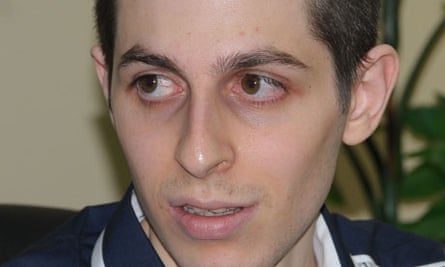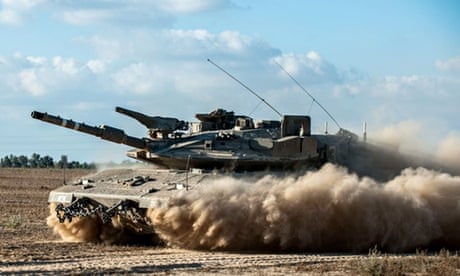The Israeli military has said one of its soldiers is missing – probably dead – in Gaza, a development that is likely to complicate diplomatic efforts to broker a ceasefire.
A statement from the Israel Defence Forces (IDF), issued on Tuesday morning, said: "In the early hours of Sunday, July 20, 2014, an armoured vehicle carrying seven soldiers of the Golani Brigade was severely damaged in battle ... The identification process of six of the soldiers killed has been completed and confirmed."
The IDF later named the missing soldier as Sgt Oron Shaul, 21, a combat soldier of the Golani brigade.
Hamas claimed on Sunday evening that it had captured a soldier, displaying an ID card and serial number, during intense fighting in Shujai'iya. Street celebrations erupted as news of the claimed abduction spread across Gaza.
However, Hamas has not produced any evidence that it is holding a live soldier. IDF sources said there was little chance that any soldier in the armoured vehicle could have survived the attack, suggesting that Hamas could have seized the body of a soldier to use as a bargaining chip.
A remote possibility is that the soldier's injuries were so devastating that the IDF has been unable to make a positive identification.

Hamas may believe that the soldier, or his body, could be used as leverage in its demand that Israel release scores of Palestinian prisoners arrested in the run-up to the present conflict. It has said it will not agree to a ceasefire until this and other demands, including the opening of Gaza's borders, are met.
Israel may also introduce the return of the soldier, or his body, as a precondition for halting its military assault.
Col Lior Lotan, former head of the IDF's Missing In Action (MIA) and Prisoner of War (POW) unit, said the Israeli military was likely to be conducting a field operation in Gaza to locate "tangible and solid evidence" of the soldier's fate.
"That could take hours, or even days," he said, adding that such an operation could impact on the next 24 hours of the military offensive.
"This is not the first time that Hamas is bargaining with Israel over bodies or parts of bodies," he said. "Hamas will use any kind of leverage in the current circumstances."
The abduction of soldiers, or the bodies of dead soldiers, is a visceral issue in Israeli society, where almost every Jewish family has a connection to the military. Most young Israelis are required to do military service after they leave school – three years for boys and two years for girls – and hundreds of thousands remain on reserve lists for decades afterwards.
Hamas and other Palestinian militant groups are well aware of the value of holding Israeli soldiers, dead or alive. Israel has a long track record of releasing Palestinian prisoners or the corpses of militants in exchange for hostages or bodies.
The Israeli military instructs its combat units to do everything possible to avoid kidnap. The "Hannibal directive" was drawn up in 1986 following the capture of two Israeli soldiers in south Lebanon. It stated: "At the time of a kidnapping the main mission becomes forcing the release of the abducted soldiers from their kidnappers, even if that means injury to our soldiers."
Israel denied it meant that Israeli soldiers should be killed by their own comrades rather than captured by the enemy. But after Hamas seized Gilad Shalit in 2006, Haaretz quoted an IDF battalion commander saying: "Under no circumstances should a soldier be taken hostage. Our soldiers do their utmost to prevent this from happening – they [are ordered] to fire at a group of abductors even if that means their IDF comrade would be killed. And the soldiers understand this fully: they cannot become another Gilad Shalit."
Shalit was seized in a cross-border raid by Hamas militants in June 2006, during which two more Israeli soldiers were killed. Aged 19 at the time of the abduction, he was held in grim conditions inside Gaza before being freed in October 2011 in a deal under which Israel released 1,027 Palestinian prisoners.
A campaign led by his family for such a deal was overwhelmingly supported by the Israeli public. The majority said his freedom was worth the enormous price eventually paid by Israel.
A month after Shalit's abduction, two Israeli soldiers were captured on the Lebanese border by Hezbollah, an incident that triggered a 34-day war. Their fate was unknown for two years, but in August 2008 the bodies of Ehud Goldwasser, 20, and Eldad Regev, 25, were returned to Israel in exchange for five Hezbollah fighters held by Israel and the remains of 199 Palestinian and Lebanese militants. Goldwasser and Regev had been killed in the ambush two years earlier.
Ron Arad, an Israeli air force pilot, has been missing since October 1986 after being captured by the Lebanese group Amal. He was later handed over to Hezbollah. A secret investigation by Israeli military intelligence concluded that he died of illness in the mid-1990s, but a UN negotiator claimed in 2008 that Hezbollah had told him Arad had been killed during an escape attempt in 1988.
